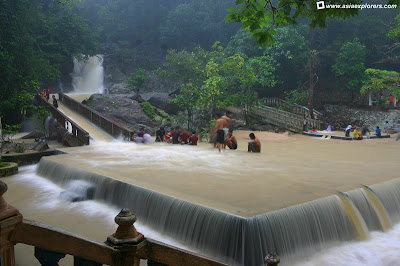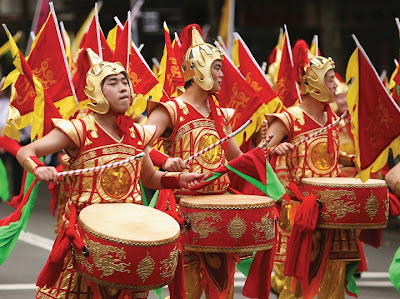The largely rural state preserves rich Malay traditions such as kite-flying contests, top-spinning contests, and bird singing competitions, and traditional handicrafts such as
batik,
songket, and silver crafts. As a border state and former vassal state of Thailand, Kelantan has absorbed influences from Thai customs and traditions that help to make the state's culture distinct from those of other states of Malaysia. The Kelantanese people, regardless of ethnic origin, are proud of their state and its unique local culture and dialect.
All the ethnicities generally live together harmoniously in Kelantan. For example, members of the Thai community received a permit to build a very large statue of the Buddha without any objection from the Malay community or the PAS government that granted the permit.
MALAY
Kelantanese
Malay dialect is distinguished from standard Malay as well as other Malay dialects by its unique grammar, pronunciation and figures of speech.
Kelantanese Malay is somewhat
partially intelligible with other Malay dialects. Whilst the
Arab script called
Jawi has less influence in the other parts of Malaysia, it is still widely used in writing and printing the Malay language in Kelantan. Signboards in Kelantan are written in both
Jawi and Rumi. To a certain extent,
Thai is also used.
95% of Kelantan's population are ethnic Malay, and under the Malaysian Constitution, all Malays are Muslims; therefore, Islam is the most influential religion in the state.
To most Malaysians, Kelantan is synonymous with Malay
arts and crafts. Kota Bharu, as the state capital, is a popular centre for such pursuits as
silat,
martial arts, and kertok drumming. Here, too, more than any other place in Malaysia, the traditional pastimes of top-spinning — known as gasing — and the flying of giant, elaborately decorated kites called wau, are still much in evidence.
THAI
The minority
ethnic Thai inhabitants of Kelantan are mostly centered in an area around the coastal town of
Tumpat, site of most of the state's two hundred or so Buddhist temples, and noteworthy for its number of relatively well-off Siamese villages.
The dialect of the
Thai language spoken in Kelantan is called "Tak Bai", after the southernmost coastal town
Tak Bai of
Narathiwat Province, just across the
Golok River from Malaysia.
Tak Bai dialect differs substantially from standard southern Thai and other regional Thai dialects, and it seems certain that the Kelantan Thais are the descendants of an original enclave of Narathiwat settlers established in sparsely populated Malay territory as long as four centuries ago.
Buddhism is also visible, in that hundreds of Thai
wats also known as 'ketik' can be found throughout the state. The longest statue of a reclining Buddha in
Southeast Asia can be found in
Wat Photivihan, in Tumpat.
The reclining Buddha at Wat Photivihan in Kelantan opened in 1980. This temple is very popular with pilgrims and devotees. The Metta Chanting is using the original language (Pali), or in Thai translation.
The Thai group will conduct the religious celebration at the Wat such as Tok'katinna,
Loy Krathong, Saibat,
Songkran, and so forth. One thousand visitors will attend this function.
CHINESE
Chinese assimilation in Kelantan is manifested as: "Malay behaviour as frontstage and Chinese behaviour as backstage". "Frontstage" or public behaviour includes speaking Kelantanese Malay even when among themselves, adopting Malay-style clothing, and observing certain Malay customs and holidays. "Backstage" or private behaviour includes maintaining certain traditional Chinese beliefs and customs confined only within the home. A pattern which they also associate as
Peranakan, nonetheless they are culturally different in some ways from the Strait-Chinese Peranakan of Malacca, Penang and Singapore or even the Indonesian Peranakans.
In Kelantan, the Chinese see themselves as either Cina
Kampung (village Chinese) or Cina Bandar (town Chinese). Famous Chinese villages in Kelantan include
Kampung Tok'kong (300-year-old temple), Batu Jong, Kampung Jelatok, Kampung Joh, Kampung Temangan, Kampung Mata Ayer, Kampung Tawang,
Kampung Balai, Gua Musang and etc. Descendants of the earlier waves of small-scale migration are known as Orang Cina kita (our very own Chinese) and the elders are seen as Orang Kelantan betul (true Kelantanese). Speaking the Kelantanese Malay dialect with fluency unites both Cina Kampung and Cina Bandar
The Chinese in Kelantan have native speaker competence in the Kelantanese dialect. It is impossible to tell a Malay from a Chinese by listening to his speech in the Kelantanese dialect, without looking at the person.
The accommodations of the Chinese population have made communication between Chinese and Malays in Kelantan both easy and common. As a consequence, Kelantanese Malay and Chinese view each other as individuals, rather than simply as representatives of cultural categories. The ability of the Chinese in Kelantan to accommodate Malay culture has facilitated significant entrepreneurial activities. They are already familiar with the term 'kulit sawo matang' that describe them for a century.
Much of Chinese culture still continues until today; such as lion and dragon dancing during the CNY, temple celebration, eating bakchang (meat dumpling), mooncake, baby fullmoon, pulut kuning, telur merah, eat 'e' (tangyuan), religious celebration including praying
Na Tuk Kong. They also cook 'bak hong', 'uang (meatball)' during the wedding ceremony and ' kiam mai' during the funeral.
The village of
Kampung Tok'kong in the Kelantan state of Malaysian is well known for a historically significant Chinese Temple known as Seng Choon Keong. 25 km from
Kota Bharu, it is located within a paddy field village with a population of around 500 person. The temple is approximately 300 years old. It is dedicated to the worship of the Goddess
Matsu. Every year on the equivalent date to the 23rd of March on the Chinese Calendar, the birthday of Mazu is commemorated with concerts, lion dance, Carrying god ride 'Kheng kiu', 'siam hee' and also wayang kulit show for three days. Chinese and Mazu followers visit the temple to pay homage to Mazu, to offer prayers for health and wealth, as well as for personal safety and security and eat Kampung Tokkong most famous 'Bak hong'. In every Friday also many follower will attend to seek help from Mazu spirit for personal problem. Annually, the Seng Choon Keong lion dance association will tour the state during the Chinese New Year to conduct traditional cultural rituals aimed at driving away evil spirits and bad luck.
Unlike the Chinese in other parts of Malaysia, Chinese Kelantanese prefer to conduct their wedding party at home rather than at a restaurant. This reflects their mindset that their presence to celebrate the newly weds is more important than the wedding banquet. And also make it a gethering ceremony to celebrate the angsu 'red/ happiness'. the more guest mean the house owner is more respectable. This is further proven by their generosity of the money gifts from the newly weds. Usually the wedding ceremony begins on Thursday night and proceeds until the next morning because the weekend holiday is Friday in Kelantan. For good luck, the groom has to bring home the bride before 12 noon on the Friday with flowers decorate car.
Most Chinese villagers bury their deceased ones at the local town cemetery. Others cremate the dead at the nearest Wat. If the deceased is old, a three-day funeral ceremony and memorial is conducted, complete with chanting from the monks. But if the deceased is of the younger generation, they are either buried or cremated as soon as possible. They also offers prayers for anniversary for the death. example: for Villager in Kg Tokkong also have cemetery known as 'Chiakka sua' located nearby Kg Tokkong. and one of the biggest cemetery in kelantan is 'Fu long sua' located in near by kem desa pahlawan.
ORANG ASLI
Orang Asli, mostly Temiar are people who have lived in the forests of Kelantan and Perak for thousands of years. Some of the Temiar maintain traditional beliefs in their natural surroundings and other forms of animist elements, while some of them have embraced Islam, instead. Kelantan shows an example of a Malaysian state in which all of races can live in the peace and harmony.
RELIGION
As of 2010 the population of Kelantan is 95.2%
Muslim, 3.8% Buddhist, 0.3%
Christian, 0.2%
Hindu, 0.5% follower of other religions or non-religious.














